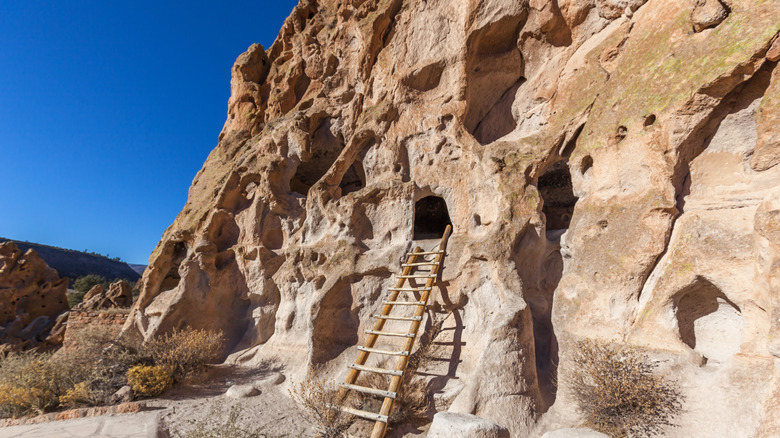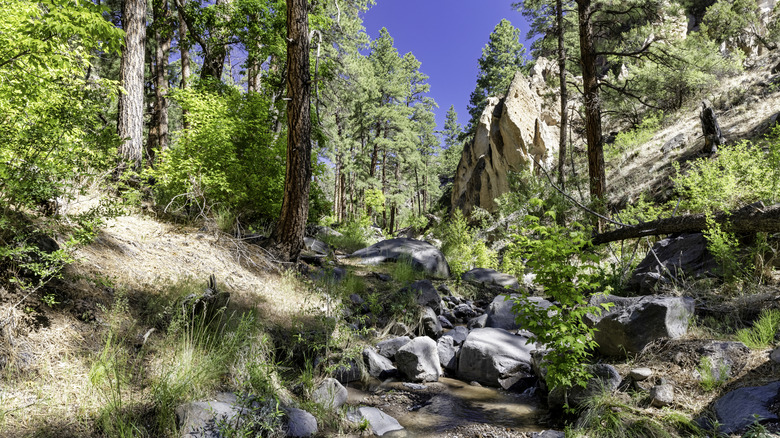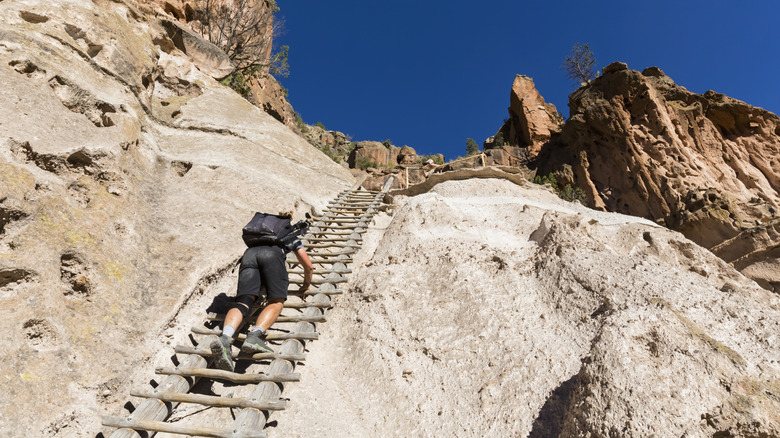New Mexico's Stunning Desert Monument Offers Scenic Trails Through Historic Ruins, Canyons, And Caves
Less than an hour north of Santa Fe — the oldest capital city in America — Bandelier National Monument protects the remains of human settlements dating back 11,000 years. This beautiful stretch of over 33,000 acres of canyon in New Mexico is the ancestral home of 23 tribes. Today, petroglyphs, cave dwellings, and cultural and agricultural architecture remain among the archaeological sites, all of which can be seen from the park's Pueblo Loop Trail, one of the park's two most popular hiking routes.
Bandelier was first formed as a national monument in 1916, protecting not just the cultural importance of the land but its unique geology. Formed by ash from volcanic eruptions, the land is marked by prominent, tall, and uneven rock formations that dot the canyon. The park itself sits on the edge of the Valles Caldera, a natural depression that was left in the earth following an eruption.
This site and its campgrounds are easily accessible by car from Santa Fe or Taos and are as beautiful as any of the southwest's major parks, like New Mexico's unique version of the badlands. With over 70 miles of trail to hike, ladders to climb into canyon-side homes, and unique cultural histories to learn about, this is a great park to spend a day or weekend exploring. If you're flying into New Mexico, it will likely be the International Sunport in Albuquerque, which is about a two-hour drive from Bandelier.
Hike some of the park's scenic trails
In terms of more traditional hiking trails, the Falls Trail is a popular option. This trail does not loop, but is a 1.5-mile-long out-and-back path that leads to a waterfall. Here, hikers can choose to hike to the Upper Falls or descend to the Lower Falls. This trail is a family-friendly option, which first climbs and then slowly descends the canyon down into a valley and then back up again for an excellent view of the falls. This trail is not paved, and while not overly difficult, it does have high drop-offs along the canyon, where you'll see the Rio Grande. Other trails at Bandelier include the Cerro Grande Route, which is a 4.6-mile loop to the park's highest point, and the 1.5-mile-long Tsankawi Trail. Ladders are required on this trail, so it may not be the best choice if visiting during winter.
As some of the terrain, particularly in the canyons, can become treacherous, hikers should stay on the designated trails. The park is at a higher altitude than some travelers may be accustomed to, and when combined with the heat (this area of New Mexico typically reaches almost 90 degrees Fahrenheit in the summer months), altitude sickness and heat stroke can occur. Park rangers suggest carrying water and snacks on your person at all times if you do plan on hiking.
Climb into Bandelier's historic ruins
Mostly made up of a paved pathway, with some excursions a few feet up into the rocky canyon-side, the Pueblo Loop Trail is one of the park's most popular hikes. The 1.4-mile loop wanders past Pueblo archaeological sites, including a kiva, farming beds, petroglyphs, and the remains of several homes. Here, you can climb some of the smaller ladders the park is famous for, and have the unique experience of crawling around inside what remains of the local cave dwellings.
The other most popular trail, the Alcove House Trail, is a 1-mile path that breaks off from the Pueblo Loop. The alcove is located 140 feet above the canyon, and can be accessed by wooden ladders as long as weather allows. If you're feeling brave enough to climb up, inside the alcove, you'll find a reconstructed kiva, an underground room used for religious ceremonies, teaching, and community gatherings by the Pueblos, and the partial remains of the homes that originally housed 25 ancestral Pueblo people.


